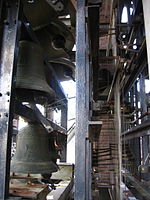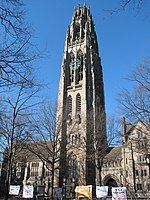Education (Chittenden Memorial Window)
Education is a stained-glass window commissioned from Louis Comfort Tiffany's Tiffany Glass Company during the building of Yale University's Chittenden Hall (now Linsly-Chittenden Hall, after being connected to a nearby building), funded by Simeon Baldwin Chittenden. Personifications of Art, Science, Religion, and Music are represented in the work, as angels. Other angelic representations of related virtues, values, and ideas attend them, each identified by words in their halos. Originally overlooking the main reading room of the then new university library when installed in 1890, the window's location is now identified as room 102 of Linsly-Chittenden Hall, on the High Street side of the building. It is accompanied by a bronze plaque which states that the window had been commissioned to commemorate the daughter of the donor, with the intent of illustrating the biblical quote, "Through wisdom is a house builded, and by understanding it is established, and by knowledge shall the chambers be filled with all precious and pleasant riches".,
Excerpt from the Wikipedia article Education (Chittenden Memorial Window) (License: CC BY-SA 3.0, Authors).Education (Chittenden Memorial Window)
High Street, New Haven
Geographical coordinates (GPS) Address Nearby Places Show on map
Geographical coordinates (GPS)
| Latitude | Longitude |
|---|---|
| N 41.3084 ° | E -72.9296 ° |
Address
Linsly-Chittenden Hall
High Street 63
06511 New Haven
Connecticut, United States
Open on Google Maps








